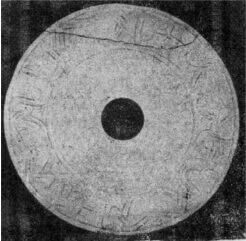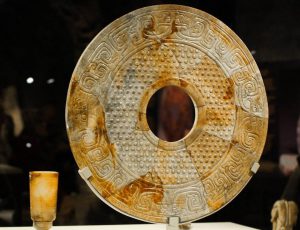
Stone Drops (2.)
 27. 02. 2017
27. 02. 2017

The successor to Karyl Robin-Evans became the well-known pair of scholars and writers Peter Krassa and Hartwig Hausdorf. At the beginning of 70. Erich von Däniken was also devoted to discs, others were French Jacques Fabrice Vallée or Italian Peter Kolosimo (Pier Domenico Colosimo).
Peter Krassa drew attention to Dropa's discs as early as 1973 in his book "Als die gelben Götter kamen" (When the Yellow Gods Came). Two years later, the Austrian engineer Ernst Wegerer told him that in 1974 he and the group and two interpreters visited the Pan-Pcho Museum near Xi'an in Shenxi Province, and to his great surprise there saw two unlabeled stone disks behind the glass. . With the help of an interpreter, he turned to the director of the museum, who did not tell him anything more about the discs, either could not or did not know. However, she allowed Wegerer to take pictures. Krassa and Wegerer met in person a few years later at an ASS (Ancient Astronaut Society) conference, and in 1983 Peter Krassa was finally able to view the photographs and use them in his next book,… und kamen auf feurigen Drachen ”(…). fire dragons).

Peter Krassa
Meanwhile, Krassa tried to get some information in writing from the Beijing Archaeological Institute, but the subconscious came the answer (after a few months) that nothing like it had ever been found in China, and the story of finding stone disks in 1938 was not real. The researcher did not give up and began searching at the Ethnological Museum in Vienna, where he found a work on the excavations of Chinese archaeologists, which was published in Beijing in 1957. To his surprise, he discovered a photograph of a disk with a hole in the middle. He had the publication translated by sinologists and learned that there was to be a jade disk in the picture. The title of the publication in English transcription Kao gu tong xun, in Czech Kchao ku tchung sün. Jadeite disks are sometimes also called Bi disks.
When Peter Krassa and his German friend and colleague Hartwig Hausdorf went to China in 1994, hoping to be as fortunate as their predecessors at the Pan-Pcho Museum, they could no longer see the discs. They were told they had been removed. During the 20 years since Weger's visit, much has changed. There was still a cultural revolution in China in the 70s, and China's reluctance to publish findings on its territory persists. The museum staff was replaced and with it the disks disappeared, at least from the display case. However, our travelers allegedly discovered a clay disk in one of the rooms, which was significantly larger than 30 cm. Upon their return, Hausdorf and Krassa published the book Satellites of the Gods.
What about Bi disks? Their dating begins around 5 BC, the Huangshan culture, and then continues with the Liangzhou culture (000 BC). Several thousand of them were found in the tombs of the Chinese aristocracy, placed next to the bodies or on the remains at the height of the heart. The disks had a hole in the middle and are sometimes associated with Drop disks. Scientists are a little unsure about working with stone, when at that time there were no metal tools, according to them they cut the stone "until they were cut". According to archaeologists, the disks were to accompany the nobles to the grave or to the "sky". Some believe that the disk was a symbol of the sun or a circle and thus a representation of the cyclicality of life and death. In the event of war, it was the duty of the humble nation to give the jade disk to the winner as a sign of acquisition.
Another interesting point is that jade disks or Bi disks are also interested in the Smithsonian Institution (Smithsonian Institution), which is associated with a few cases repairing inconvenient history, including the total destruction of inappropriate artifacts.





 6
6

